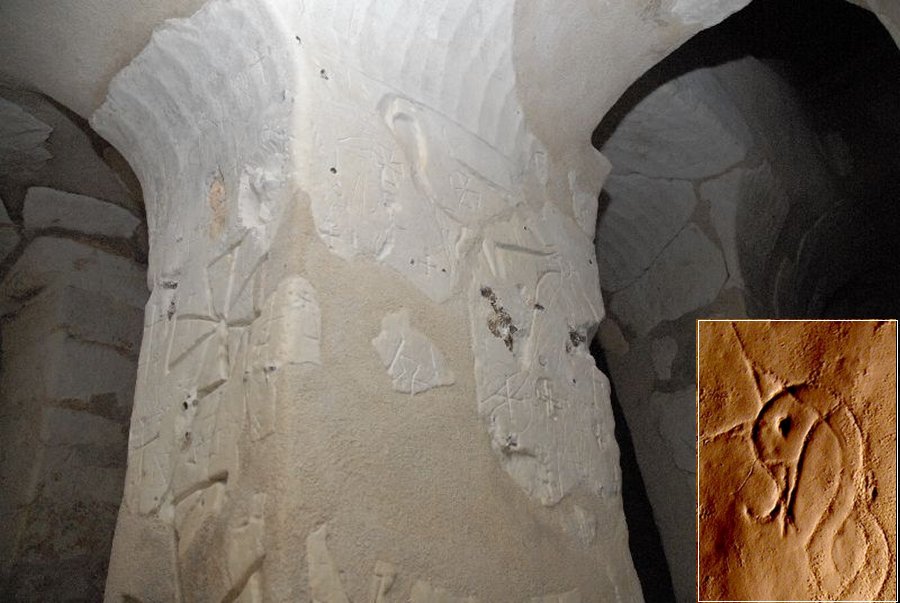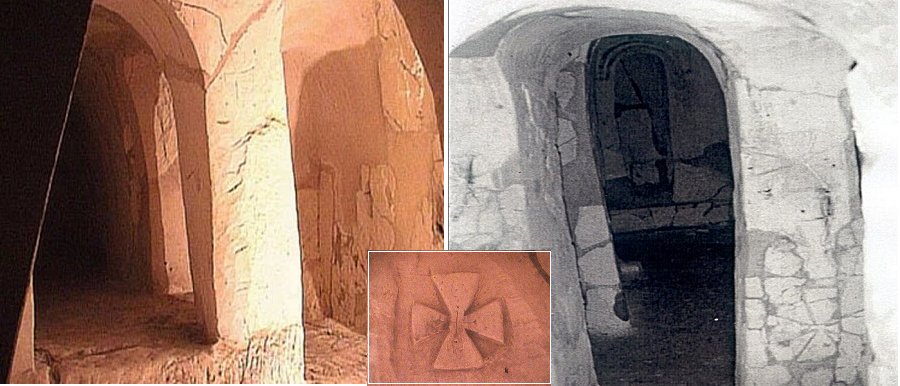Ancient Cave Church Complex In Basarabi, Romania
A. Sutherland - AncientPages.com - In 1957, a complex of caves, crypts,. six chapels, and tombs dated to 9-10th century, was found near Murfatlar, a port on the Danube-Black Sea Canal, Constanta County, Romania.
Ancient cave monastery in Basarabi was dug into the chalky limestone hill at several, different levels, into the vertical walls of the ancient quarry. Between 1924–1965 and 1980–2007, the town Murfatlar (in Turkish, "generous man") was known as Basarabi and this name is still used in respect to ancient cave complex.
Most of the chamber-walls are covered with overlapping graffiti, including drawings and multilingual inscriptions carved on the walls in Old Slavic, some in Greek alphabet and some in Turkic runes and some in Romanian. There are also runic signs, which still remain a scientific mystery.
The Basarabi culture concentrated in Southeastern Europe, mainly in Romania and dated between 8th - 7th centuries BC. It was named after Basarabi, a village in Dolj County, south-western Romania, today, an administrative part of the Calafat municipality.
This culture is related to the Hallstatt culture of the Iron Age period, the Hallstatt A (12-11th BC) and B (10-8th BC) corresponds to the late Bronze Age, Hallstatt C (7th BC) to the early Iron Age, and Hallstatt D (6th BC) to the Iron Age.
Like in some cultures of the region, the human settlements of the Basarabi culture, were usually open but sometimes also fortified, however, dwellings differed considerably within one culture.
They ranged from pit-dwellings and small huts to two-roomed rectangular houses, between 6 to 8 meters long and 3-4 meters wide.
Platforms which were frequently used in the Neolithic period, were not excavated, however, the living are of these people was equipped with a stamped clay floor.
In "Encyclopedia of Ancient Greece", Nigel Wilson writes: “the territory of modern-day Romania has been populated from the Palaeolithic period, but the country’s historical period begins in the 9th-8th centuries BC and is connected in southwestern Europe with the so-called Thracian Hallstatt period (c.600-550 BC), which corresponds to European Hallstatt C. Basarabi culture is considered the most representative of this new period within Romanian territory. The population was formed of mainly agricultural tribes living in fortified or open villages whose dwellings were constructed of timber….”
The caves of the Basarabi Church complex were discovered richly decorated with numerous drawings on the walls, depicting animals and men, riders, birds, and Christian symbols.
A large series of drawings is represented by mythical figures of monsters and dragons, along with halberds and an image of a Viking ship depicted on the walls, are all in favor of a northern origin.
During the years 1957-1962, an important monastic complex Basarabi, was discovered, near a big chalk quarry.
See also:
Mysterious Cucuteni-Trypillian Culture Burned Their Settlements For Unknown Reasons
Mysterious Underground Labyrinth With Secret Passages In Dobrogea
Spectacular Vardzia Cave Monastery – Huge Underground Complex Founded By The “Mountain Queen” Tamar
Researchers have linked these discoveries to the trade route between Scandinavian areas and Constantinople, known under the name “the route from the Varegs (= Vikings) to the Greek”.
However, they still have difficulty trying to decipher runic texts in Basarabi, due to their fragmentary preservation and the absence of many elements. It is not even known if they were written from left to right or from right to left.
For the time being, the runic writings remain undeciphered.
Written by – A. Sutherland - AncientPages.com Senior Staff Writer
Copyright © AncientPages.com All rights reserved. This material may not be published, broadcast, rewritten or redistributed in whole or part without the express written permission of AncientPages.com
Expand for referencesReferences:
Cambridge Ancient History (second addition, volume III)
More From Ancient Pages
-
 7,000-Year-Old Grains Hints At Origin Of Swiss Pile Dwellings
Archaeology | Mar 3, 2022
7,000-Year-Old Grains Hints At Origin Of Swiss Pile Dwellings
Archaeology | Mar 3, 2022 -
 Dracula: Cruel, Ruthless And Bloodthirsty Ruler But Not A Vampire
Featured Stories | Sep 12, 2023
Dracula: Cruel, Ruthless And Bloodthirsty Ruler But Not A Vampire
Featured Stories | Sep 12, 2023 -
 Ancient Mystery From The Age Of Taurus And The Murdered Astronomer – Evidence In The Arctic ? – Part 2
Ancient Mysteries | Nov 1, 2019
Ancient Mystery From The Age Of Taurus And The Murdered Astronomer – Evidence In The Arctic ? – Part 2
Ancient Mysteries | Nov 1, 2019 -
 Amazing ‘Sigiriya’- ‘Lion Rock’ Fortress In Sri Lanka With Frescoes, Mirror Wall And Miniature Gardens
Civilizations | Jan 4, 2019
Amazing ‘Sigiriya’- ‘Lion Rock’ Fortress In Sri Lanka With Frescoes, Mirror Wall And Miniature Gardens
Civilizations | Jan 4, 2019 -
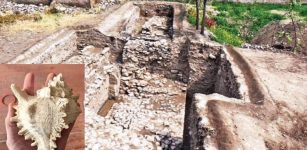 Second Gate Of Bazira And Unique Artifacts Discovered In The Ancient City Of Alexander The Great
Archaeology | Mar 29, 2022
Second Gate Of Bazira And Unique Artifacts Discovered In The Ancient City Of Alexander The Great
Archaeology | Mar 29, 2022 -
 Unexpected And Surprising Results Of Ancient DNA Study – Who Were The First People In South America?
Archaeology | Nov 2, 2022
Unexpected And Surprising Results Of Ancient DNA Study – Who Were The First People In South America?
Archaeology | Nov 2, 2022 -
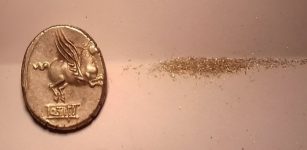 Romans Were Early Pioneers Of Recycling – New Evidence Reveals
Archaeology | Oct 17, 2023
Romans Were Early Pioneers Of Recycling – New Evidence Reveals
Archaeology | Oct 17, 2023 -
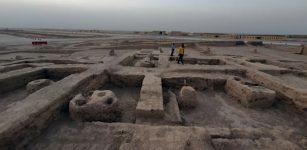 Ancient Parthian City With Hundreds Of Artifacts Unearthed In Iraq
Archaeology | Aug 16, 2022
Ancient Parthian City With Hundreds Of Artifacts Unearthed In Iraq
Archaeology | Aug 16, 2022 -
 Mysterious 9,000-Year-Old Shaman Burial In Bad Dürrenberg – One Of Central Europe’s Most Spectacular Archaeological Discoveries
Featured Stories | Sep 15, 2023
Mysterious 9,000-Year-Old Shaman Burial In Bad Dürrenberg – One Of Central Europe’s Most Spectacular Archaeological Discoveries
Featured Stories | Sep 15, 2023 -
 Makhunik – 5,000-Year-Old City Of Dwarfs Who Hoped To Return One Day
Civilizations | May 28, 2014
Makhunik – 5,000-Year-Old City Of Dwarfs Who Hoped To Return One Day
Civilizations | May 28, 2014 -
 Caribbean Silk Cotton Tree And Its Dangerous Spirits In Myths And Legends
Featured Stories | Jan 29, 2024
Caribbean Silk Cotton Tree And Its Dangerous Spirits In Myths And Legends
Featured Stories | Jan 29, 2024 -
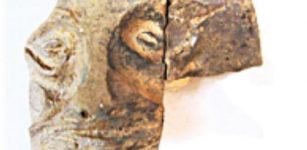 Satyr Mask Discovered In Ancient Greek Emporium Pistiros In Thracians’ Odrysian Kingdom Near Bulgaria’s Vetren
Civilizations | Sep 22, 2015
Satyr Mask Discovered In Ancient Greek Emporium Pistiros In Thracians’ Odrysian Kingdom Near Bulgaria’s Vetren
Civilizations | Sep 22, 2015 -
 Massive Underground Anomaly – Iron Ages Temples And Seat Of Legendary Ulster Kings Discovered At Navan Fort?
Archaeology | Jul 21, 2020
Massive Underground Anomaly – Iron Ages Temples And Seat Of Legendary Ulster Kings Discovered At Navan Fort?
Archaeology | Jul 21, 2020 -
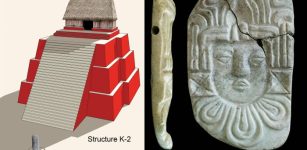 Fire-Burning Event At The Maya Kingdom Of K’anwitznal Was A Reaction To Regime Change
News | Apr 19, 2024
Fire-Burning Event At The Maya Kingdom Of K’anwitznal Was A Reaction To Regime Change
News | Apr 19, 2024 -
 Young Boy Finds A Huge Tooth From A Prehistoric Shark In South Carolina
Archaeology | Sep 3, 2022
Young Boy Finds A Huge Tooth From A Prehistoric Shark In South Carolina
Archaeology | Sep 3, 2022 -
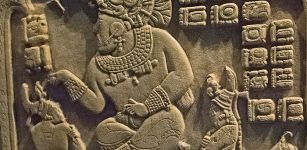 Fall Of The Ancient Maya Civilization Not Caused By Climate Change And Environmental Degradation – Scientists Say
Archaeology | Nov 18, 2021
Fall Of The Ancient Maya Civilization Not Caused By Climate Change And Environmental Degradation – Scientists Say
Archaeology | Nov 18, 2021 -
 Impressive Marble Statue Of A Ram, An Ancient Christian Symbol For Jesus Discovered
Ancient Symbols | Dec 28, 2015
Impressive Marble Statue Of A Ram, An Ancient Christian Symbol For Jesus Discovered
Ancient Symbols | Dec 28, 2015 -
 Discovery Of Second Viking Site Point Rosee In North America Could Re-Write Ancient History
Archaeology | Apr 1, 2016
Discovery Of Second Viking Site Point Rosee In North America Could Re-Write Ancient History
Archaeology | Apr 1, 2016 -
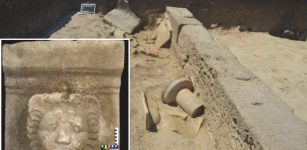 Outstanding Unfinished Ancient Marble Carving Of A Lion’s Head Found Near Selinunte, Sicily
Archaeology | Sep 2, 2023
Outstanding Unfinished Ancient Marble Carving Of A Lion’s Head Found Near Selinunte, Sicily
Archaeology | Sep 2, 2023 -
 On This Day In History: Treaty of Bergerac Ratified – On Sep 17, 1577
News | Sep 17, 2016
On This Day In History: Treaty of Bergerac Ratified – On Sep 17, 1577
News | Sep 17, 2016


